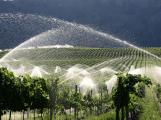1
Steady growth in the Okanagan suggests that there will be further expansion and prosperity for the town of Oliver. There are factors, however, which limit how much growth is possible, and how many people the town's resources can support. Boasting some of the highest water consumption rates per-capita in North America, Oliver's renewable reservoirs and are quickly nearing their output capacities. Improvements for technology and water-use habits exist, however, and a more conservative path could guarantee water for generations to come.2
Panoramic Photograph of Oliver24 July 2008
Oliver, British Columbia, Canada
 Credits:
Credits:Sabyan, Gregory
3
Despite living in one of the driest regions of North America, people in the Okanagan consume massive amounts of water. In 2005, Oliver residents consumed an average of 1304 litres of water per day. Nearby Penticton, for comparison, consumes only 700 litres per person per day. The average citizen in the capital of New Mexico, Santa Fe, consumed just over 380 litres in 2007.5
Annual precipitiation in Oliver is low, and the precipitation that does come is insufficient for the agricultural community we have developed. Oliver depends on water flowing from further north in the watershed as the source for water. While there seems to be plenty of water in the Okanagan watershed, it is mostly fossil water. The top metre of Okanagan Lake is all that is replenished on an annual basis.At the current rate of growth, consumption, and climate change, it is expected that Oliver's water use will be doubled by 2041. Local sources will be at their sustainable limits by 2019.
6
Mean Annual Precipitiation for Oliver, compared to Vancouver and Toronto18 December 2008
Oliver, British Columbia, Canada
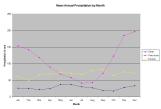 Credits:
Credits:Based on Environment Canada Climate Data, accessed by internet December 18, 2008
7
Oliver's single largest water use is irrigation. During the growing season, 96% of water consumed is used to irrigate orchards and farms. It is also during these hotter summer months that domestic irrigation and consumption peak. For these reasons, two of the most efficient ways for Oliver residents to consume less water are xeriscaping, and reducing water lost to evaporation.8
Above the tree irrigation, demonstrating inefficient water use9 August 2006
Oliver, British Columbia, Canada
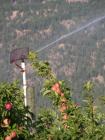 Credits:
Credits:Russell Work
9
Xeriscaping is the process of replacing high-demand flowers and lawns with native, drought-resistant species. Often, these plants can survive on rainfall alone, requiring little, if any, additional watering and maintenance.10
Xeriscaping by the Town of Oliver17 November 2008
Oliver, British Columbia, Canada
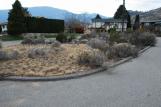 Credits:
Credits:Russell Work
11
Evaporation can be controlled by changing watering habits, and changing the irrigation technology. For example, sprinklers watering on a sunny day can lose as much as 60% efficiency to evaporation. Drip-line sprinklers and soaker hoses do not spray water through the air, so evaporation is drastically decreased. This, combined with nighttime watering, can virtually eliminate evaporative loss.Implementing these strategies together would reduce water use in Oliver by as much as 30% over the next ten years.
12
Mini-jet sprinkler, which focuses on the root system of plants22 July 2006
Oliver, British Columbia, Canada
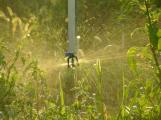 Credits:
Credits:Russell Work
13
The canal was designed to deliver 230 cubic feet, or about 6500 litres of water per minute. In 2001, about 5024 litres of water were consumed per minute. This figure has dropped somewhat, but water usage in Oliver continues to exceed 70% capacity.14
Photograph of flume showing newer anti-corrosion steel24 July 2008
Oliver, British Columbia, Canada
 Credits:
Credits:Sabyan, Gregory
